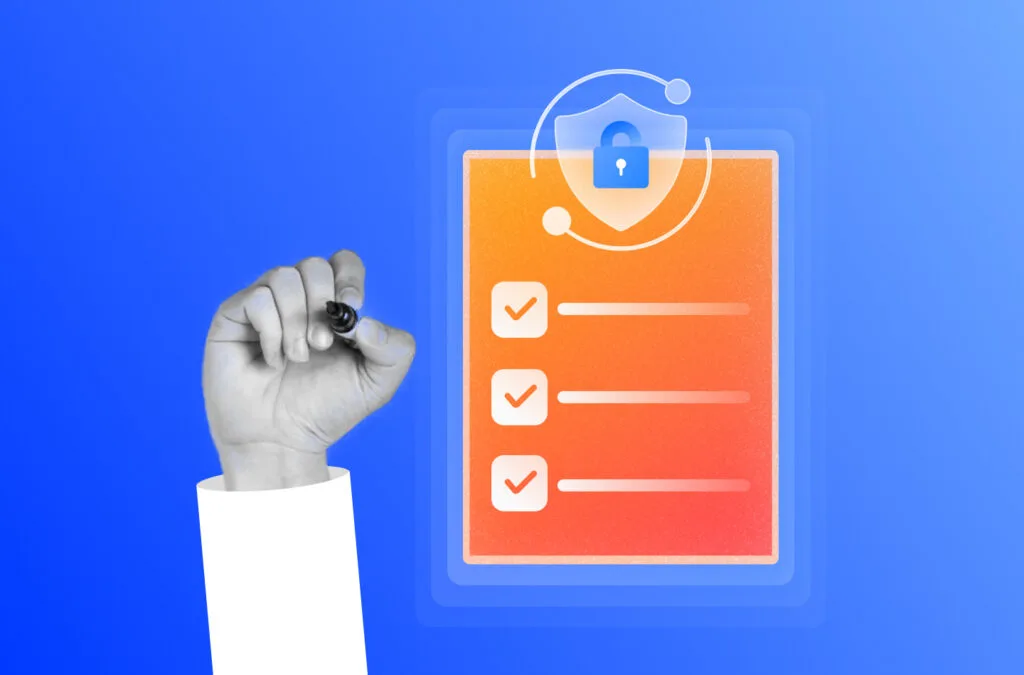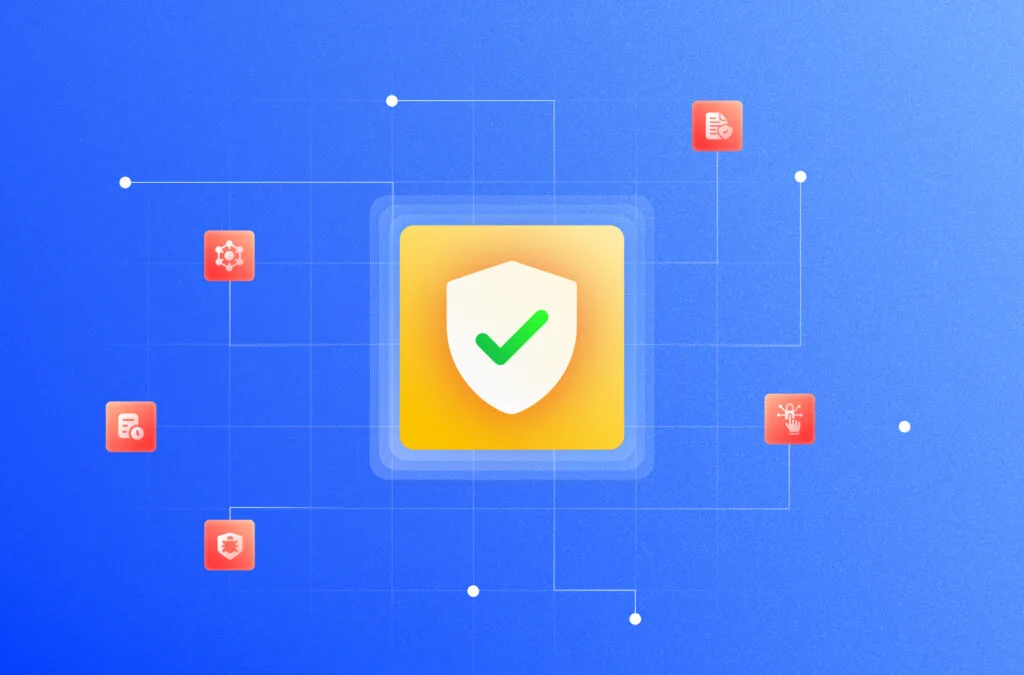Cybersecurity is a constant race between attackers and defenders, where countermeasures must be implemented before hackers exploit vulnerabilities—otherwise, your organization risks becoming just another statistic. In such a scenario, ‘deeper insights and fast response’ are the only key strategies to maintain visibility and stay ahead. Enter network security audits.
A network security audit provides a comprehensive overview of weaknesses that attackers can exploit to infiltrate the system. It enhances your confidence in the security controls in place and helps with frictionless business operations.
This blog serves as your go-to guide for network security audits. It covers a detailed checklist, the essential steps, and the tools needed to conduct an effective audit.
| Regular audits identify vulnerabilities, protect data, enhance performance, ensure compliance with standards like GDPR and HIPAA, and ensure business continuity. |
| Critical areas to focus on include evaluating firewalls, access controls, encryption methods, network segmentation, and patch management to identify potential weaknesses and ensure a robust security posture. |
| To conduct a network security audit, define audit scope, gather documentation, assess risks, perform vulnerability tests, and ensure compliance while analyzing performance. |
What is a Security Audit?
A security audit is a comprehensive assessment of an organization’s systems, processes, and policies that evaluates the security posture and verifies compliance with applicable standards. These audits aim to identify weak or missing controls leading to security risks and compliance gaps and provide recommendations for improvement.
Security audits can be categorized as internal, external, compliance, technical, and operational audits. A network security audit falls under a technical audit.
What is a Network Security Audit?
A network security audit systematically evaluates an organization’s network infrastructure to identify vulnerabilities and misconfigurations, assess the overall security stance, and detect compliance misses. The goal is to minimize the risks of unauthorized access, data breaches, and downtime while ensuring resilience against emerging threats.
Why are Network Security Audits Important?
Network security audits are critical to ensure that the organization maintains a resilient security posture against threats and does not resort to reactive measures. It is also crucial to optimize security investments and ensure no business disruptions in case of an unforeseen event.
Here’s why you must perform network audits regularly:
Identify exploitable vulnerabilities
In the famous Capital One breach in 2019, a former Amazon Web Services (AWS) employee exploited a misconfiguration in the cloud infrastructure that exposed 100 million customer records. This could have been easily avoided by a comprehensive network security audit also focused on the cloud. These audits aim to identify exploitable vulnerabilities before the attackers to minimize such threats and breaches.
Protect sensitive data
Network security audits help protect sensitive data by evaluating access controls, identifying security weaknesses such as open ports or outdated software, monitoring unauthorized activity, and ensuring compliance with data protection regulations such as GDPR or PCI DSS.
Enhance network performance
These audits proactively identify threats, malware, and any issues in the network while identifying overused and underused resources. This helps with risk reduction and resource optimization, allowing the networks to operate at peak efficiency. The review of network segmentation also ensures that data flows efficiently and that, even in the case of a security event, the impact on operations is minimized.
Ensure business continuity
Network security audits validate disaster recovery, and incident response plans to improve response times and ensure that backup and redundancy systems are correctly configured when required. Any downtime risks are also monitored and minimized to ensure business continuity.
Maintain compliance
Many industry-specific regulations, such as HIPAA, PCI-DSS, GDPR, and ISO 27001, require secure transmission, encryption controls, access controls, and segmentation for data protection. Network audits help verify compliance with these standards and identify gaps for quick resolution.
Take control of your security and compliance with Sprinto
Key Aspects to Check During a Network Security Audit
Some key areas to focus on during a network security audit include configurations, access permissions, network segmentation, encryption protocols, patch management practices, and logging and monitoring
Here’s a detailed network security audit checklist that you can follow:
Network architecture
- Review network topology and design for segmentation, use of secure protocols, and other best practices
- Check for misconfigurations, such as open ports and use of default settings
Internal policies
- Review key policies such as acceptable usage policy, remote access policy, encryption policy, privacy policy, and network security policy
- Evaluate adherence to standard operating procedures to eliminate the risk of shadow IT practices
Password Strategy
- Ensure strong passwords and frequent password changes
- Verify the use of the password manager
Access controls and authentication
- Evaluate role-based access controls and the principle of least privilege
- Verify multi-factor authentication (MFA)
Firewall and perimeter security
- Confirm the effectiveness of Intrusion Detection Systems/Intrusion Prevention Systems
- Block any unauthorized open ports
- Inspect firewall rules
Patch management and software updates
- Ensure all network devices and software are up-to-date
- Review the effectiveness of automated patch management software
Endpoint security
- Verify the effectiveness of Endpoint Detection and Response (EDR) tools and Mobile Device Management (MDM) tools
- Ensure all endpoints are covered with up-to-date antivirus and antimalware software
Data protection and encryption
- Check for encryption of data at rest and in transit
- Assess the handling and disposal of sensitive data
Wireless network security
- Review wireless network configurations such as encryption and strong passwords
- Verify separate networks for guests and employees
- Check for access points installed without the network owner’s permission, also known as rogue access points
Vulnerability assessments and Pen tests
- Conduct vulnerability scans and pen tests to uncover potential threats and vulnerabilities
- Review the testing schedule for VAPT scans
User awareness training
- Assess cybersecurity training completion rates for employees
- Evaluate policies for reporting incidents
Network monitoring and logging
- Verify centralized logging and monitoring systems
- Check for log retention policies
Incident response and recovery
- Evaluate the effectiveness of the incident response plan
- Check for backup and restoration processes
How is a Network Security Audit Performed?
A network security audit is performed using a structured process. A suite of tools is used to scan for vulnerabilities, conduct risk assessments, test controls, and monitor activity, followed by the compilation and review of reports.
Check out these 8 steps to perform the audit:
1. Define audit scope and objectives
Determine the scope of the network audit to decide which internal networks, cloud services, routers, firewalls, and other components must be audited. The next step would be to set goals such as detecting vulnerabilities, ensuring compliance, enhancing incident response times, and optimizing network performance. Also, the key stakeholders involved in the audit, such as IT teams or compliance officers, must be identified, and everyone must be communicated about the audit plan.
2. Gather necessary documentation and information
Start collecting network diagrams, data flow maps, and configuration details. Review security policies and standard operating procedures. Gather information on compliance requirements to map the audit to applicable frameworks.
Create an inventory of all digital assets and identify the crown jewels, such as sensitive data repositories, servers, and databases.
3. Identify risks
Use risk assessments to identify key risks to the network, such as malware, DDoS attacks, insider threats, and ransomware. Assess the likelihood and impact of each risk and prioritize risks based on the assessment. This will allow you to plan for focused testing for critical risks and assets.
4. Conduct VAPT scans
Conduct vulnerability scans and pen tests using tools like Nessus or Metasploit to identify vulnerabilities, misconfigurations, and unpatched software and test network defenses. These tools will also help you generate customized VAPT reports to provide insights into an organization’s readiness against attacks.
5. Test controls
Test security controls as per the network audit checklist—verify access controls, strong passwords, endpoint security, secure configurations for wireless networks, and incident response plans to analyze the security posture and identify weaknesses in design or implementation.
6. Analyze performance
Use tools like Wireshark to understand overused or underused resources and analyze network traffic. Also, ensure proper network segmentation to limit the spread after an incident. This analysis will provide insights into network performance and lay the foundation of a tactical plan to optimize it further.
7. Verify compliance
Ensure that there are adequate compliance checks and security measures as per the applicable frameworks. Verify that the security and compliance policies are enforced across all network components and that employee training programs have been arranged to inform them of security best practices.
8. Report findings
Gather and document findings in a detailed report to be shared with the top management. Include key details on vulnerabilities, misconfigurations, compliance gaps, and high-priority risks. Discuss actionable remediation steps and a re-assessment schedule for severe findings with the executives. Use continuous monitoring tools to monitor network security and stay consistently abreast of evolving threats.
Automate security and compliance control testing
Who Conducts a Network Security Audit?
Internal IT security teams, external firms, consultants, penetration testers, regulatory and compliance teams, and MSSPs can conduct a network audit. The choice of auditor depends on the nature and scope of the business, the complexity of operations, and organizational requirements.
Each of these brings their strengths and limitations. For example, while an internal auditor may be cost-effective, they may be biased towards the internal processes and may not give a fair view of the security stance.
Check out this table to understand which auditor is suitable when:
| Who conducts the audit? | When to use? | Advantage | Disadvantage |
| Internal IT security team | For regular internal checks | Cost-effective Understanding of internal systems | Potential for bias Lack of expertise |
| External audit firms | For an objective, unbiased evaluation | Third-party perspective Advanced tools | Higher costs Requires time to understand systems |
| Consultants | For a tailored approach | Objective assessment Well-versed with compliance regulations | Short-term engagements Dependency risk |
| Pen testers | For testing network defenses | Identifies hidden weaknesses with real-world simulations | Limited coverage of network assessment |
| Regulatory and compliance teams | For regulated industries seeking expertise | Helps ensure compliance Can help accelerate audits | Formal processes |
| Managed Security Service Providers (MSSPs) | For outsourced network management needs | Ongoing monitoring Scalable solutions | Organizations get Less control over internal security processes |
Tools Used in Network Security Audits
There’s no one-size-fits-all formula for this, and the choice of tool depends on alignment with security goals, scope of audits, ease of use, and costs. Most organizations use a combination of vulnerability scanners, pen testing tools, network configuration management tools, and other use-case tools for a comprehensive approach.
Here’s a quick comparison of tools you can choose from:
Vulnerability scanners
These tools identify vulnerabilities, misconfigurations, and other weaknesses in networks. Examples include:
- Nessus: A popular and widely-used vulnerability scanner that helps with vulnerability assessments, scores, and configuration audits with Six Sigma accuracy.
- Qualys: A cloud-based tool suitable for enterprise vulnerability management, continuous monitoring, risk remediation, and compliance checks.
Penetration testing tools
Pen test tools simulate cyberattacks to find exploitable vulnerabilities. For example:
- Kali Linux: An open-source Linux distribution with pen testing, ethical hacking, and other security auditing tools
- Burp Suite: A web application pen-testing tool that provides manual testing tools like intruders and scans for vulnerabilities like SQL injections and XSS.
Intrusion detection and prevention systems
These tools identify and prevent malicious or suspicious activities in the network. Here are the examples:
- Suricata: An open-source IDS and IPS tool that monitors and alerts on malicious network traffic to protect against exploits and unauthorized access attempts
- Snort: A Cisco-backed open-source IDS and IPS that actively blocks malicious traffic in real-time based on defined rules.
Network scanners
Network scanners map network structures and discover network devices, services, and open ports. For example:
- Nmap: An open-source network scanning tool that helps system admins and network engineers with inventory, port scanning, service detection, OS detection, and assessing firewall rules.
- Angry IP scanner: A quick, lightweight, and open-source network scanning tool that helps with port scans and IP address monitoring to detect any issues.
Network traffic analysis tools
These tools monitor and analyze network traffic to capture unusual behavior or anomalies. Top examples include:
- Wireshark: A popular network protocol analyzer that deeply inspects data packets to provide real-time insights into network traffic and activity.
- TCPdump: A flexible tool that uses a command-line interface and analyzes data packets to monitor and troubleshoot network issues.
Compliance management tools
Compliance management tools audit networks to ensure compliance with relevant standards. Here are some examples:
- Sprinto: A compliance automation platform that integrates with various vulnerability scanners for real-time vulnerability policing and monitors network configurations to help ensure compliance.
- Vanta: A compliance management tool that continuously monitors network security settings to keep the network secure and audit-ready.
Firewall configuration management tools
Firewall configuration management tools monitor any changes to firewall configurations to ensure security and compliance. Examples of tools in this category include:
- AlgoSec: A tool that ensures firewall configurations align with security policies, compliance standards, and business requirements while detecting redundant and risky firewall rules.
- FireMon: A firewall management tool that offers continuous visibility into firewall rules and configurations while offering actionable remediation steps for unused or overly permissive rules.
Security Information and Event Management systems
These tools collect, analyze, and correlate logs and events from various sources in the network to detect suspicious activity. For example:
- Splunk Enterprise Security: A powerful SIEM tool that offers intelligent insights into network traffic using continuous and comprehensive log analysis.
- IBM QRadar: An advanced SIEM solution that helps with real-time threat detection and risk-based prioritization and offers audit-ready reports for compliance purposes.
Configuration auditing tools
These tools audit network devices and system configurations and ensure best practices are followed for security settings. For example:
- Nipper: A specialized tool for device configuration analysis, such as routers, switches, and firewalls, to identify security issues and compliance gaps.
- SolarWinds Network Configuration Manager: A comprehensive tool that helps manage and audit network device configurations while regularly backing them up to enable quick recovery during an incident.
Wireless network auditing tools
As the name suggests, these tools assess the security of wireless networks for rogue access points and other threats. Some notable examples are:
- Aircrack-ng: A suite of tools that help identify weaknesses in wireless network encryption and authentication mechanisms through packet capture, analysis, and network monitoring.
- Kismet: An open-source tool for wireless network detection that identifies rogue access points and captures wireless traffic logs for detailed analysis.
Web application security scanners
These are designed to detect security issues in web applications. Top names in the category include:
- Acunetix: An automated web application security scanner that helps detect misconfigurations, unpatched software, and vulnerabilities such as SQL injections and XSS.
- Invicti: A specialized tool for Dynamic Application Security Testing (DAST) capabilities that help uncover vulnerabilities in network services and web servers to ensure application-layer and network-layer security.
Sprinto can help with network security and compliance
Suppose you are trying to navigate through a dynamic regulatory environment, scale security and compliance efforts, and do not have the time for constant oversight or manual inputs. In that case, a compliance automation platform is the right approach. Tools like Sprinto can help you manage your network security and compliance needs without compromising thoroughness.
Sprinto’s vulnerability management module helps you manage and track controls across networks, codes, and deployments in real-time. Automated alerts are sent through multiple channels in case of deviations to proactively fix any deviations.
The platform seamlessly integrates with your tech stack and automatically collects evidence to keep you audit-ready across 30+ frameworks while enhancing your network security posture.
Talk to an expert and take a platform tour to kickstart your journey.
FAQs
How much does a network security audit cost?
A network security audit can cost anywhere from $3000 to more than $150000, depending on factors such as organization size, scope of the audit, geographical location, duration of the audit, and auditor expertise (a Big 4 firm will charge more).
- A basic assessment for small businesses can range from $3000-$10000, which will include basic vulnerability scans and configuration reviews
- A medium business opting for in-depth vulnerability assessment, pen tests, network architecture review, and incident response evaluation can pay anywhere from $15000-$50000
- A large enterprise requiring detailed risk assessments, advanced penetration testing, and remediation support can pay between $50000 and more than $150000 for the audit.
What are some best practices for network security audits?
Some best practices for network security audits are:
- Adopt a risk-based approach
- Align network security audits with business goals
- Document everything and keep the documentation up-to-date
- Validate that the vulnerabilities are exploitable after testing
- Promote a security-first culture
- Focus on continuous monitoring and improvements
When should a network security audit be performed?
A network security audit should be performed at regular intervals. The general practice is annually or bi-annually, depending on the industry’s risk profile and the sensitivity of the information. Audits are also performed after major infrastructure changes, incidents, or organizational changes, such as mergers or acquisitions.
Payal Wadhwa
Payal is your friendly neighborhood compliance whiz who is also ISC2 certified! She turns perplexing compliance lingo into actionable advice about keeping your digital business safe and savvy. When she isn’t saving virtual worlds, she’s penning down poetic musings or lighting up local open mics. Cyber savvy by day, poet by night!
Explore more
research & insights curated to help you earn a seat at the table.






















